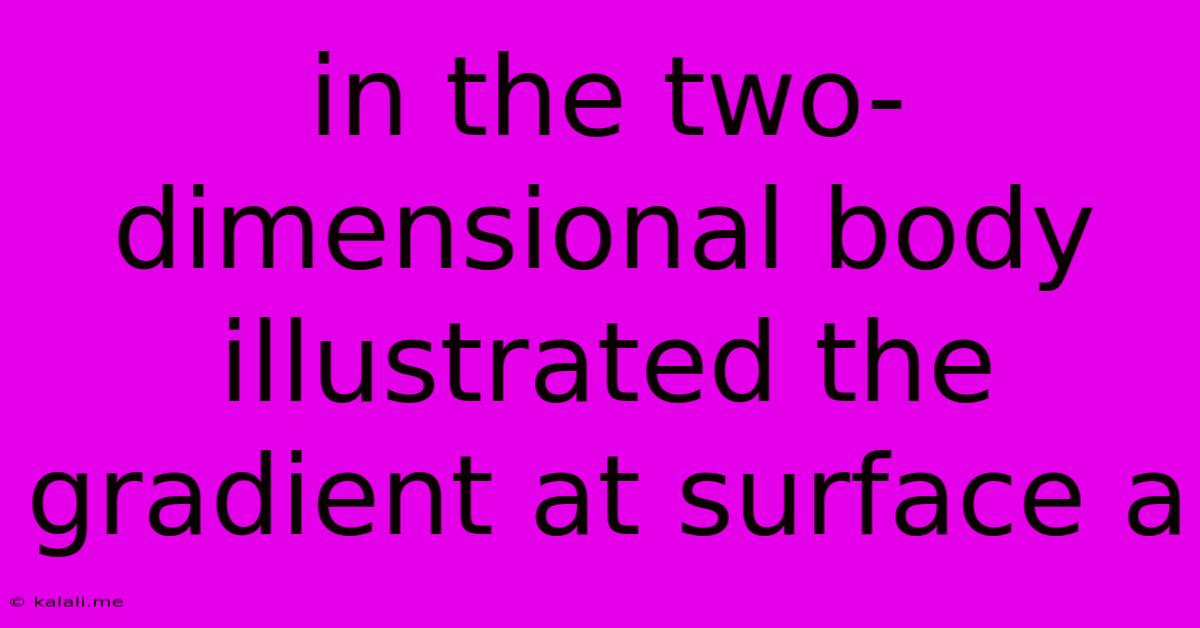In The Two-dimensional Body Illustrated The Gradient At Surface A
Kalali
Jun 15, 2025 · 3 min read

Table of Contents
Understanding the Gradient at a Surface in a 2D Body
This article explores the concept of the gradient at a surface within a two-dimensional body. We'll delve into its definition, calculation, physical significance, and applications, focusing on how to visualize and understand this important concept in fields like physics and engineering. Understanding gradients is crucial for solving problems involving heat transfer, fluid flow, and other physical phenomena.
What is a Gradient?
In the context of a two-dimensional body, the gradient at a surface refers to the rate of change of a scalar field at that specific point on the surface. Think of the scalar field as a property that varies across the body, such as temperature, pressure, or concentration. The gradient itself is a vector quantity, meaning it has both magnitude and direction. The magnitude indicates the steepness of the change, while the direction points towards the direction of the greatest increase in the scalar field.
Visualizing the Gradient
Imagine a topographic map representing elevation. The lines of constant elevation are called contour lines. The gradient at any point on the map is perpendicular to the contour line passing through that point and points uphill – towards the direction of the steepest ascent. The length of the gradient vector is proportional to the steepness of the slope. This analogy extends perfectly to other scalar fields; the gradient always points towards the direction of the most rapid increase.
Calculating the Gradient in 2D
For a scalar field f(x, y) defined in a two-dimensional space, the gradient is given by:
∇f = (∂f/∂x) i + (∂f/∂y) j
Where:
- ∇ is the del operator.
- ∂f/∂x is the partial derivative of f with respect to x.
- ∂f/∂y is the partial derivative of f with respect to y.
- i and j are the unit vectors in the x and y directions, respectively.
The partial derivatives represent the rate of change of f along the x and y axes. The gradient vector combines these rates of change to give the overall direction and magnitude of the steepest ascent.
Physical Significance and Applications
The gradient has numerous applications across various scientific and engineering disciplines:
-
Heat Transfer: The gradient of temperature represents the temperature gradient, which drives heat flow from hotter to colder regions according to Fourier's Law.
-
Fluid Dynamics: The pressure gradient drives fluid flow. Fluid flows from regions of high pressure to regions of low pressure.
-
Electromagnetism: The electric field is the negative gradient of the electric potential.
-
Image Processing: Gradients are used to detect edges and features in images. High gradient magnitudes indicate sharp changes in intensity, such as edges.
-
Material Science: Gradients in material properties can be used to create functional materials with tailored properties.
Examples and Further Exploration
Consider a simple example: a two-dimensional plate with a temperature distribution given by *f(x, y) = x² + y². Calculating the gradient will show that the direction of the steepest temperature increase is always radially outwards from the origin.
Further exploration of this topic might involve examining the relationship between the gradient and the normal vector to a surface, understanding how to apply the gradient theorem, or exploring its use in more complex scenarios like those involving non-uniform materials or boundary conditions. Understanding the gradient at a surface provides a fundamental tool for analyzing many physical systems.
Latest Posts
Latest Posts
-
How Many Heart Chambers Does A Crocodile Have
Jun 16, 2025
-
Which Of The Following Are Magnifying Lenses
Jun 16, 2025
-
What Is The Si For Volume
Jun 16, 2025
-
How Many Ones Are There Between 1 And 100
Jun 16, 2025
-
The Expected Activity Time In Pert Analysis Is Calculated As
Jun 16, 2025
Related Post
Thank you for visiting our website which covers about In The Two-dimensional Body Illustrated The Gradient At Surface A . We hope the information provided has been useful to you. Feel free to contact us if you have any questions or need further assistance. See you next time and don't miss to bookmark.